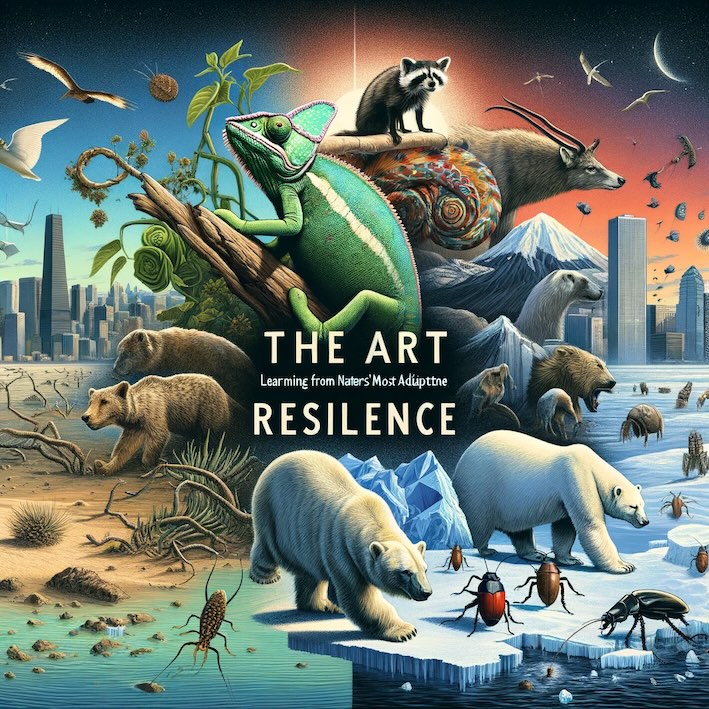There are so many lessons we can learn from nature. Here are some of them:
- Resource Availability and Reproductive Strategies
- Example in Nature: Many animal species, including some rodents and primates, adjust their reproductive rates based on resource availability. In times of scarcity, they tend to breed less.
- Human Lesson: This reflects on the importance of resource management and environmental awareness in human societies. It underscores how economic and environmental factors can influence human population trends and societal behaviors.
- Societal Structures in Bonobos vs. Chimpanzees
- Example in Nature: Bonobos, living in resource-rich environments, tend to have matriarchal and more egalitarian societies, with less aggression and more sexual freedom. In contrast, chimpanzees, often in resource-scarcer settings, show more male dominance and aggressive behaviors.
- Human Lesson: This highlights how the availability of resources can shape societal norms, gender roles, and conflict resolution strategies. It suggests that abundance or scarcity can significantly impact cultural development and social interactions.
- Competition and Cooperation in Predator-Prey Dynamics
- Example in Nature: The evolutionary arms race between predators and prey shows a constant adaptation for survival. Predators develop more efficient hunting techniques, while prey evolve better defense mechanisms.
- Human Lesson: This dynamic is analogous to competition in human contexts, like business or technology, where constant innovation is necessary. It also shows the balance between competition and cooperation for mutual survival.
- Adaptation and Learning in Crows and Ravens
- Example in Nature: Crows and ravens are known for their problem-solving abilities and use of tools, adapting to urban environments by learning from experiences.
- Human Lesson: This underlines the importance of adaptability, continuous learning, and creativity in human development. It shows how learning from the environment and past experiences is crucial for progress.
- Social Structures and Conflict Resolution in Wolf Packs
- Example in Nature: Wolf packs have complex social structures with clear hierarchies, yet they exhibit sophisticated methods of conflict resolution without resorting to serious violence.
- Human Lesson: This demonstrates the importance of structured leadership and effective conflict resolution in human societies. It emphasizes the value of social order balanced with empathy and non-violent communication.
These examples from nature offer nuanced insights into how environmental factors, resource availability, societal structures, and adaptive behaviors influence both animal and human societies. They provide a deeper understanding of the mechanisms behind population changes, social structures, competition, and adaptation, offering valuable lessons for human societal and personal development.
What don’t we know?
Exploring the lessons from nature, particularly focusing on the products and chemicals animals create that could be beneficial for humans, along with insights from evolution and competition, opens up a myriad of fascinating avenues. Here’s a list of potential areas to explore:
- Biochemical Products from Animals for Medicine:
- Venom from snakes and spiders for pain relief and treating heart conditions.
- Anticoagulants from leeches for surgery and blood disorder treatments.
- Shark cartilage in cancer research.
- Frog skin peptides for potential antibiotic and antiviral applications.
- Animal Behavioral Strategies and Human Psychology:
- Pack hunting strategies for insights into teamwork and leadership.
- Mating rituals for understanding human attraction and courtship.
- Territorial behaviors for concepts of personal space and resource management.
- Animal Adaptations and Human Technology:
- Biomimicry in design, such as the aerodynamics of bird flight informing airplane design.
- The study of animal eyes for improving camera and visual technology.
- Mimicking plant photosynthesis for sustainable energy solutions.
- Ecosystem Balance and Environmental Management:
- Keystone species and their role in ecosystem stability.
- Predator-prey dynamics for understanding sustainable resource usage.
- Animal migration patterns for insights into climate change impacts.
- Animal Social Structures and Human Societal Models:
- Hierarchy and role distribution in wolf packs and primate societies.
- Cooperative breeding in birds for insights into communal child-rearing.
- Eusociality in bees and ants for understanding efficient communal living.
- Evolutionary Biology and Genetic Adaptations:
- Adaptive radiations, such as in the Galápagos finches, for understanding speciation.
- Convergent evolution examples for insights into problem-solving under similar environmental pressures.
- Genetic adaptations in extremophiles for biotechnology applications.
- Interspecies Relationships and Symbiosis:
- Mutualism examples like the clownfish and sea anemone for partnership models.
- Parasitism and its effects on host species for understanding exploitative relationships.
- Commensalism examples for insights into non-harmful coexistence.
- Animal Navigation and Human Exploration:
- The magnetic navigation of birds for advancements in compass technology.
- Deep-sea exploration inspired by adaptations of marine creatures.
- Animal migration strategies for insights into GPS and mapping technologies.
- Animal Intelligence and Learning:
- Problem-solving in crows and octopuses for artificial intelligence research.
- Social learning in dolphins and primates for educational models.
- Memory and recall abilities in elephants for neuroscience studies.
- Animal Defense Mechanisms and Human Safety:
- Camouflage techniques for advancements in stealth technology.
- Chemical defenses in skunks and bombardier beetles for non-lethal defense mechanisms.
- Structural defenses like turtle shells for protective gear design.
Each of these areas offers a rich opportunity to learn from nature’s intricate mechanisms, potentially leading to groundbreaking innovations in medicine, technology, environmental management, and social structures. Nature, with its millions of years of evolution, provides a vast repository of knowledge and solutions waiting to be explored and adapted to human needs and challenges.
